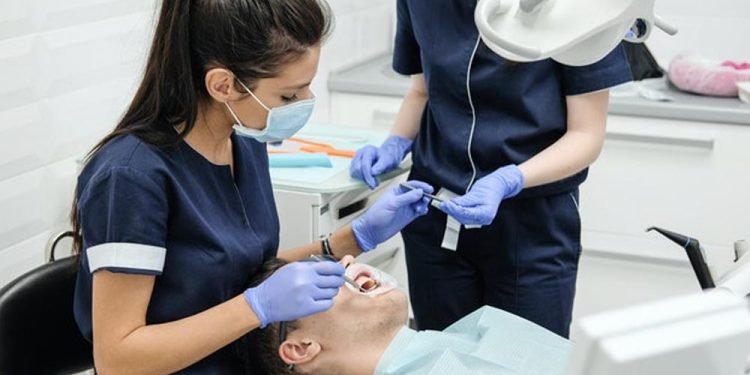Dentistry has come a long way in recent decades, with innovative procedures and cutting-edge technologies transforming the way dental professionals approach restorative and cosmetic dentistry. Among these advancements, composite bonding and all-on-four dental implants have emerged as groundbreaking solutions to address various dental issues. These state-of-the-art techniques provide patients with aesthetically pleasing, functional, and long-lasting results. In this article, we will explore the potential of composite bonding and all-on-four implants, delving into their advantages, limitations, and the future of these groundbreaking dental procedures.
Composite Bonding: A Minimally Invasive Solution
A. Definition and procedure
Composite bonding is a cosmetic dentistry procedure that involves the application of tooth-colored resin material to the surface of a damaged or discolored tooth. This technique can be used to address a wide range of dental imperfections, including chipped, cracked, stained, or misaligned teeth.
The composite bonding procedure typically involves the following steps:
- The dentist first selects a shade of composite resin that closely matches the patient’s natural tooth color.
- The surface of the tooth is prepared by lightly etching it, followed by the application of a bonding agent.
- The composite resin material is then applied to the tooth surface, sculpted to achieve the desired shape and contour, and hardened using a curing light.
- The bonded tooth is then polished and smoothed to match the surrounding teeth’s appearance and texture.
B. Advantages of Composite Bonding
- Aesthetic improvements: Composite bonding offers a highly customizable and aesthetic solution for correcting dental imperfections. The composite resin material can be meticulously matched to the patient’s tooth color and shaped to create a natural-looking result.
- Preservation of natural tooth structure: One of the key advantages of composite bonding is its minimally invasive nature. This technique typically requires minimal or no removal of the natural tooth structure, preserving the patient’s healthy teeth and reducing the risk of complications.
- Fast and cost-effective: Composite bonding cost is way more affordable and also a much quicker procedure compared to other restorative and cosmetic dental treatments. In most cases, the entire process can be completed in a single dental visit, and the results are immediate.
C. Limitations and considerations
While composite bonding offers numerous benefits, it may not be the ideal solution for every dental issue. Some limitations of this procedure include:
- Durability: Composite bonding materials may not be as strong or long-lasting as other restorative materials like porcelain or zirconia. Over time, the bonded resin material may wear, chip, or stain, necessitating replacement or repair.
- Not suitable for extensive dental damage: Composite bonding is most effective for addressing minor to moderate dental imperfections. For more extensive damage or tooth loss, alternative treatments such as dental crowns, bridges, or implants may be more appropriate.
D. Patient testimonials
Many patients who have undergone composite bonding report significant improvements in the appearance and function of their teeth. These individuals often express increased confidence in their smiles and satisfaction with the minimally invasive nature of the procedure.
All-on-Four Dental Implants: A Full-Arch Restoration
A. Definition and procedure
All-on-four dental implants are a comprehensive solution for patients with extensive tooth loss or those in need of full-arch restorations. This innovative technique involves the strategic placement of four dental implants in the upper or lower jaw, which support a fixed, full-arch prosthesis.
The all-on-four dental implant procedure generally involves the following steps:
- Initial consultation and treatment planning: The dentist or oral surgeon will evaluate the patient’s oral health, bone structure, and overall suitability for the procedure. This may involve taking dental impressions, X-rays, and CT scans to plan the precise placement of the implants.
- Implant surgery: The patient is given local anesthesia or sedation, and the dental professional surgically places four dental implants in the jawbone. These implants are typically positioned at specific angles to maximize the available bone and provide optimal support for the prosthesis.
- Temporary prosthesis placement: Following implant surgery, the patient may be fitted with a temporary prosthesis to restore function and aesthetics while the implants integrate with the jawbone.
- Healing and osseointegration: Over the next few months, the dental implants will fuse with the patient’s jawbone through a process called osseointegration, providing a stable foundation for the final prosthesis.
- Final prosthesis placement: Once the implants have fully integrated with the jawbone, the patient returns for the placement of the permanent, custom-made full-arch prosthesis.
B. Advantages of all-on-four implants
- Improved functionality and aesthetics: All-on-four dental implants offer a comprehensive solution for patients with extensive tooth loss, providing improved chewing efficiency, speech clarity, and facial aesthetics. The full-arch prosthesis is custom-designed to suit the patient’s unique facial features and preferences, resulting in a natural-looking and comfortable restoration.
- Bone preservation: One of the primary benefits of dental implants, including the all-on-four technique, is their ability to preserve the patient’s jawbone. Dental implants act as artificial tooth roots, stimulating the bone and preventing the bone loss commonly associated with tooth loss and traditional dentures.
- Long-lasting results: With proper care and maintenance, all-on-four dental implants can provide long-lasting results. The implants themselves may last a lifetime, while the full-arch prosthesis may require replacement after several years of wear.
C. Limitations and considerations
Despite the numerous advantages of all-on-four dental implants, there are some factors to consider:
- Surgical procedure: All-on-four dental implants require a surgical procedure, which may not be suitable for all patients due to health issues or personal preferences.
- Cost: The all-on-four procedure can be expensive, with costs ranging from $15,000 to $35,000 per arch, depending on various factors such as geographic location, materials used, and the complexity of the case.
- Not suitable for all cases: Although the all-on-four technique is an excellent solution for many patients, it may not be appropriate for individuals with insufficient bone density, ongoing periodontal disease, or other complicating factors.
D. Patient testimonials
Many patients who have received all-on-four dental implants report life-changing improvements in their oral health, functionality, and self-esteem. They often express gratitude for the restoration of their ability to eat a wide variety of foods and the enhanced aesthetics of their smiles.
Comparing Composite Bonding and All-on-Four Implants
A. Key differences
Composite bonding and all-on-four dental implants differ significantly in their applications, procedures, and outcomes. Some key differences include:
- Scope of treatment: Composite bonding is best suited for addressing minor to moderate dental imperfections, while all-on-four dental implants are designed to restore full arches of missing teeth.
- Invasiveness: Composite bonding is a minimally invasive procedure that preserves the natural tooth structure, whereas all-on-four dental implants involve a surgical procedure and the placement of titanium implants in the jawbone.
- Durability and longevity: While both treatments can provide long-lasting results, all-on-four dental implants may offer greater durability and longevity compared to composite bonding, particularly in cases of extensive tooth loss.
B. Selecting the appropriate procedure based on patient needs
When determining the most suitable dental procedure, several factors must be taken into account, including the patient’s oral health, the extent of dental imperfections, personal preferences, and budget. Consulting with a dental professional is essential to evaluate the patient’s unique needs and determine the most appropriate treatment option.
C. Consultation with a dental professional
Before deciding on a treatment, it is crucial to consult with a dental professional who can assess the patient’s oral health, discuss the benefits and limitations of each procedure, and provide personalized recommendations. This may involve a comprehensive dental examination, X-rays, and a thorough discussion of the patient’s goals and expectations.
The Future of Composite Bonding and All-on-Four Implants
A. Technological advancements
As dental technologies continue to advance, it is likely that composite bonding and all-on-four dental implants will become even more refined and effective. For instance, the development of new composite materials may offer improved durability, aesthetics, and ease of application, while advancements in implant design and surgical techniques may further enhance the success rates and patient outcomes associated with all-on-four procedures.
B. Increased accessibility and affordability
As innovative dental procedures become more mainstream, their accessibility and affordability are expected to increase. This may involve the expansion of dental insurance coverage for these treatments, as well as the introduction of new financing options to help patients manage the costs associated with composite bonding and all-on-four dental implants.
C. The role of preventive care
While composite bonding and all-on-four dental implants offer remarkable solutions for various dental issues, it is essential to recognize the importance of preventive care in maintaining oral health. Regular dental check-ups, professional cleanings, and a diligent at-home oral hygiene routine can help prevent the need for more extensive dental treatments and ensure the longevity of existing restorations.
Conclusion
Composite bonding and all-on-four dental implants represent significant advancements in the field of dentistry, offering patients innovative solutions to address a wide range of dental imperfections. Both procedures have the potential to unlock life-changing improvements in oral health, function, and aesthetics, ultimately enhancing patients’ quality of life and self-confidence.
To determine the most suitable treatment option, it is essential to consult with a dental professional from a reliable oral surgery clinic who can assess the patient’s unique needs and provide personalized recommendations. As dental technologies continue to evolve, the potential of composite bonding and all-on-four dental implants will only grow, transforming the landscape of restorative and cosmetic dentistry for years to come.












